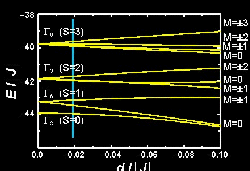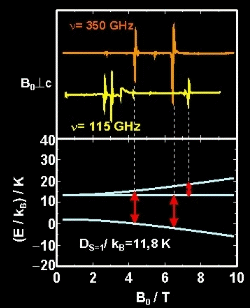Magnetism of polynuclear metal complexes
Magnetic molecules are promising candidates for new magnetic materials. Polynuclear metal complexes may serve as building blocks for molecule based magnetic materials. The magnetic properties of these complexes are in-between those of mono-nuclear complexes and classical inorganic compounds of extended crystal lattices. The interplay between the magnetic ions and the organic ligand molecules i.e. the magnetic coupling of the ions, the magnetic anisotropy and the properties of the coupled system of magnetic ions are studied by magnetic measurements and numerical calculations.
As an example the following figures show the results obtained the compound Fe6(tea)6 (details B. Pilawa et al. Appl. Magn. Reson. 21,527-34 (2002)).
Examples
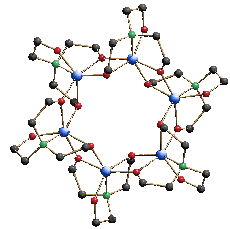 Magnetic molecules are promising candidates for new magnetic materials. Polynuclear metal complexes may serve as building blocks for molecule based magnetic materials. The magnetic properties of these complexes are in-between those of mono-nuclear complexes and classical inorganic compounds of extended crystal lattices. The interplay between the magnetic ions and the organic ligand molecules i.e. the magnetic coupling of the ions, the magnetic anisotropy and the properties of the coupled system of magnetic ions are studied by magnetic measurements and numerical calculations.The Fe6(tea)6 complex is highly symmetric which facilitates the investigation of the magnetic properties. Six iron(III) ions (blue dots) are coupled in a cyclic structure by the triethanolaminate(3-) (tea) ligand.
Magnetic molecules are promising candidates for new magnetic materials. Polynuclear metal complexes may serve as building blocks for molecule based magnetic materials. The magnetic properties of these complexes are in-between those of mono-nuclear complexes and classical inorganic compounds of extended crystal lattices. The interplay between the magnetic ions and the organic ligand molecules i.e. the magnetic coupling of the ions, the magnetic anisotropy and the properties of the coupled system of magnetic ions are studied by magnetic measurements and numerical calculations.The Fe6(tea)6 complex is highly symmetric which facilitates the investigation of the magnetic properties. Six iron(III) ions (blue dots) are coupled in a cyclic structure by the triethanolaminate(3-) (tea) ligand.
As an example the following figures show the results obtained the compound Fe6(tea)6 (details B. Pilawa et al. Appl. Magn. Reson. 21,527-34 (2002)).
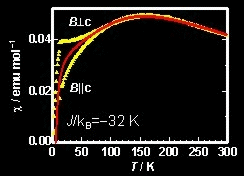
The magnetic susceptibility (yellow triangles) of Fe6(tea)6 resembles above ~70 K the temperature dependence of a quasi one-dimensional antiferromagnet.
The properties of the finite spin systems become obvious at low temperatures, when the system condenses into the S=0 ground state.
The red line results from the isotropic Heisenberg exchange Hamiltonian.
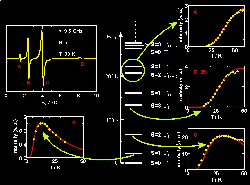 The energy levels predicted by the isotropic Heisenberg Hamiltonian can be confirmed by electron spin resonance (ESR).
The energy levels predicted by the isotropic Heisenberg Hamiltonian can be confirmed by electron spin resonance (ESR).
The temperature dependent intensity of the recorded resonances is determined by the excitation energy of the corresponding energy levels. This is shown in the following figure (enlargement).
ESR provides detailed information about the magnetic anisotropy. The right figure shows the splitting of the first excited S=1 state and indicates those transitions which can be attributed to resonances in the ESR spectra. The comparison with the results of numerical calculations reveals that the magnetic anisotropy is caused by the single ion anisotropy of the iron(III) ions and the intra molecular dipolar interaction. Due to the high symmetry of the Fe6(tea)6 the experimental results can be modelled with one parameter with accounts for the single ion anisotropy. The left figure shows the splitting of the lowest S-states due to the ligand-field interaction. The blue line in the left figure indicates the level splitting observed by ESR.
